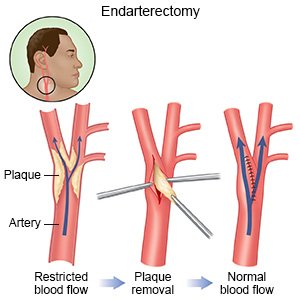Femoral Artery Endarterectomy
Medically reviewed by Drugs.com. Last updated on Aug 4, 2025.
AMBULATORY CARE:
What you need to know about femoral artery endarterectomy (FAE):
FAE is surgery to remove plaque (fatty deposits) from inside your femoral artery. The femoral artery is a large blood vessel found near your groin. It supplies blood to your legs. Plaque may build up inside your femoral artery and decrease blood flow to your legs.
How to prepare for FAE:
- Your surgeon will tell you how to prepare. Your surgeon may tell you not to eat or drink anything after midnight on the day of your surgery. Arrange to have someone drive you home when you are discharged.
- Tell your surgeon about all medicines you currently take. Your surgeon will tell you if you need to stop any medicine for surgery, and when to stop. Your surgeon will tell you if you need to take aspirin or a blood-thinning medicine before surgery. This medicine will help stop clots from forming in your blood. Your surgeon will tell you which medicines to take or not take on the day of surgery.
- Tell your surgeon about any allergies you have, including to anesthesia or medicines.
- You may need blood tests before surgery. You may also need an ultrasound, CT scan, or MRI. Tell the healthcare provider if you have ever had an allergic reaction to contrast liquid. Do not enter the MRI room with anything metal. The MRI machine uses a powerful magnet. Metal can cause serious injury from the magnet. Tell the healthcare provider if you have any metal in or on your body. The tests may be done to check the plaques in your femoral artery. Angiography may be used to check the blood flow from your femoral artery to your legs.
What will happen during FAE:
- You will be given general anesthesia to keep you asleep and free from pain during surgery. Your surgeon will make an incision over the femoral artery near your groin. Clamps will be applied to the artery to stop blood flow and mark the area that has plaque. Your surgeon will make an incision in the artery. The plaque will be separated from the artery wall and removed.
- Your surgeon may inject saline into the artery to check for any remaining plaque. This will also show if blood will be able to flow through the artery properly. The artery incision will be closed or put back together with a patch. The patch may be made from animal tissue or a piece of your own vein. The patch helps keep the artery open so it does not become too narrow again.
- Your surgeon will remove the clamps and check the blood flow in your artery. A drain may be used to remove extra blood and fluid from around your artery. Your groin incision will be closed with stitches and covered with a bandage.
 |
What to expect after FAE:
- You will be taken to a recovery room until you are fully awake. Healthcare providers will monitor you closely for any problems. You may need to stay in the hospital overnight or longer.
- Talk to healthcare providers before you get up the first time. They may need to help you stand up safely. When you are able to get up on your own, sit or lie down right away if you feel weak or dizzy. Then press the call light button to let healthcare providers know you need help.
- You may need to take blood thinners and aspirin. Your surgeon will tell you how long you will need these medicines.
Risks of FAE:
You may bleed more than expected. Your incision site may develop an infection or hematoma (collection of blood). You may develop a blood clot. Nerves or other structures near the surgery site may be damaged. Your artery may be damaged or weakened. This can cause a rupture. An artery rupture is life-threatening.
Call your local emergency number (911 in the US), or have someone call if:
- You have any of the following signs of a stroke:
- Numbness or drooping on one side of your face
- Weakness in an arm or leg
- Confusion or difficulty speaking
- Dizziness, a severe headache, or vision loss
- You have chest pain or trouble breathing.
Related medications
Seek care immediately if:
- Your arm or leg feels warm, tender, and painful. It may look swollen and red.
- Your stitches come apart.
- Your incision site has increased bruising or swelling.
- Your incision site is red, warm to the touch, or draining fluid.
Call your doctor or surgeon if:
- You have new or worsening numbness or weakness in your legs.
- You have a fever.
- You have questions or concerns about your condition or care.
Medicines:
You may need any of the following:
- Blood thinners help prevent blood clots. Clots can cause strokes, heart attacks, and death. Many types of blood thinners are available. Your healthcare provider will give you specific instructions for the type you are given. The following are general safety guidelines to follow while you are taking a blood thinner:
- Watch for bleeding and bruising. Watch for bleeding from your gums or nose. Watch for blood in your urine and bowel movements. Use a soft washcloth on your skin, and a soft toothbrush to brush your teeth. This can keep your skin and gums from bleeding. If you shave, use an electric shaver. Do not play contact sports.
- Tell your dentist and other healthcare providers that you take a blood thinner. Wear a bracelet or necklace that says you take this medicine.
- Do not start or stop any other medicines or supplements unless your healthcare provider tells you to. Many medicines and supplements cannot be used with blood thinners.
- Take your blood thinner exactly as prescribed by your healthcare provider. Do not skip a dose or take less than prescribed. Tell your provider right away if you forget to take your blood thinner, or if you take too much.
- NSAIDs , such as ibuprofen, help decrease swelling, pain, and fever. This medicine is available with or without a doctor's order. NSAIDs can cause stomach bleeding or kidney problems in certain people. If you take blood thinner medicine, always ask your healthcare provider if NSAIDs are safe for you. Always read the medicine label and follow directions.
Care for the area as directed:
Wear loose-fitting clothing over the area. Do not get the area wet until your healthcare provider says it is okay. When it is okay to bathe, do not scrub the area. Just let water run over it. Dry the area and put on new, clean bandages as directed. Change your bandages when they get wet or dirty. Do not put powders or lotions over your incision. Check the area every day for signs of infection, such as swelling, redness, or pus.
Self-care:
- Do not lift anything heavy until your healthcare provider says it is okay. This may be for a few weeks after surgery.
- Ask when you can return to your regular daily activities. Your provider will tell you when you can go back to work, drive, or do other activities.
- Eat a variety of healthy foods. Healthy foods include fruit, vegetables, whole-grain breads, low-fat dairy products, lean meat, and fish. Choose fish that are high in omega-3 fatty acids, such as salmon and fresh tuna. Ask your provider for more information on a heart healthy diet and the DASH eating plan.

- Do not smoke. Nicotine and other chemicals in cigarettes and cigars can cause blood vessel damage. Ask your healthcare provider for information if you currently smoke and need help to quit. E-cigarettes or smokeless tobacco still contain nicotine. Talk to your provider before you use these products.
Follow up with your doctor or surgeon as directed:
You may need to have tests to check the blood flow to your legs. Write down your questions so you remember to ask them during your visits.
© Copyright Merative 2025 Information is for End User's use only and may not be sold, redistributed or otherwise used for commercial purposes.
The above information is an educational aid only. It is not intended as medical advice for individual conditions or treatments. Talk to your doctor, nurse or pharmacist before following any medical regimen to see if it is safe and effective for you.
Further information
Always consult your healthcare provider to ensure the information displayed on this page applies to your personal circumstances.
